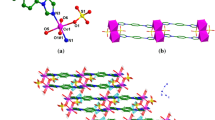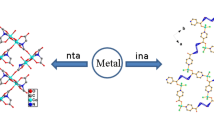Abstract
Two new Co(II) coordination polymers, namely {[Co(μ-fum)0.5(μ-obix)2(H2O)](NO3)}n (1), {[Co(μ-fum)0.5 (μ-mbix)2(H2O)](NO3)}n (2), (H2fum: fumaric acid, obix:1,2-bis(imidazol-1-yl-methyl)benzene, mbix: 1,3-bis(imidazol-1-yl-methyl)benzene), have been successfully synthesized under hydrothermal conditions. They have been structurally characterized by elemental analysis, IR spectra, single crystal X-ray diffraction, powder X-ray diffraction (PXRD), magnetic properties. Single-crystal X-ray analysis reveals that the asymmetric units of both CPs contain a Co(II) ion, half fumarate ligand, two bis(imidazole) ligands, one aqua ligand and a nitrate ion. While two symmetry-related Co1 ions are connected by one fumarate ligand to generate a dinuclear unit and obix ligand links adjacent dinuclear units through the nitrogen atoms to form a 1D double chains in 1, each mbix ligand links two Co1 ions to form 1D double chains, and the adjacent chains are further linked together by fumarate ligands to form a 2D network in 2. The effect of bis(imidazole) ligands, which are o- and m-isomers, on the dimensionality of the formed coordination polymer was investigated. The reason for this great effect of bis(imidazole) ligands is that adjustments in the framework occur result of the bending of the semi-rigid imidazole ligands. Thermal analysis shows that 1 and 2 possess similar thermal behaviors. The optical band gap energy values of 1 and 2 observed 3.24 eV and 3.21 eV, respectively. This small difference in the band gap energy may be due to the difference in structural arrangement.











Similar content being viewed by others
REFERENCES
S. Zhang, Q. Yang, X. Liu, X. Qu, Q. Wei, G. Xie, S. Chen, and S. Gao. High-energy metal–organic frameworks (HE–MOFs): Synthesis, structure and energetic performance. Coord. Chem. Rev., 2016, 307, 292-312. https://doi.org/10.1016/j.ccr.2015.08.006
S. Qiu and G. Zhu. Molecular engineering for synthesizing novel structures of metal–organic frameworks with multifunctional properties. Coord. Chem. Rev., 2009, 253(23/24), 2891-2911. https://doi.org/10.1016/j.ccr.2009.07.020
N. Li, R. Feng, J. Zhu, Z. Chang, and X.-H. Bu. Conformation versatility of ligands in coordination polymers: From structural diversity to properties and applications. Coord. Chem. Rev., 2018, 375, 558-586. https://doi.org/10.1016/j.ccr.2018.05.016
W. P. Lustig, S. Mukherjee, N. D. Rudd, A. V. Desai, J. Li, and S. K. Ghosh. Metal–organic frameworks: functional luminescent and photonic materials for sensing applications. Chem. Soc. Rev., 2017, 46(11), 3242-3285. https://doi.org/10.1039/c6cs00930a
S.-N. Zhao, Y. Zhang, S.-Y. Song, and H.-J. Zhang. Design strategies and applications of charged metal organic frameworks. Coord. Chem. Rev., 2019, 398, 113007. https://doi.org/10.1016/j.ccr.2019.07.004
M. Du, R. Banerjee, and G. K. H. Shimizu. Structural design of coordination polymers. CrystEngComm, 2013, 15(45), 9237. https://doi.org/10.1039/c3ce90156d
Q.-T. He, X.-P. Li, L.-F. Chen, L. Zhang, W. Wang, and C.-Y. Su. Nanosized coordination cages incorporating multiple Cu(I) reactive sites: host–guest modulated catalytic activity. ACS Catal., 2013, 3(1), 1-9. https://doi.org/10.1021/cs300640r
A. Kuznetsova, V. Matveevskaya, D. Pavlov, A. Yakunenkov, and A. Potapov. Coordination polymers based on highly emissive ligands: synthesis and functional properties. Materials, 2020, 13(12), 2699. https://doi.org/10.3390/ma13122699
Y.-X. Sun and W.-Y. Sun. Zinc(II)– and cadmium(II)–organic frameworks with 1-imidazole-containing and 1-imidazole-carboxylate ligands. CrystEngComm, 2015, 17(22), 4045-4063. https://doi.org/10.1039/c5ce00372e
M. O′Keeffe and O. M. Yaghi. Deconstructing the crystal structures of metal–organic frameworks and related materials into their underlying nets. Chem. Rev., 2012, 112(2), 675-702. https://doi.org/10.1021/cr200205j
J. Xu, X.-Q. Yao, L.-F. Huang, Y.-Z. Li, and H.-G. Zheng. Syntheses, structures, photoluminescence and magnetic properties of four new metal–organic frameworks based on imidazoleligands and aromatic polycarboxylate acids. CrystEngComm, 2011, 13(3), 857-865. https://doi.org/10.1039/c0ce00219d
G.-P. Yang, L. Hou, L.-F. Ma, and Y.-Y. Wang. Investigation on the prime factors influencing the formation of entangled metal–organic frameworks. CrystEngComm, 2013, 15(14), 2561. https://doi.org/10.1039/c3ce26435a
D. Zhao, D. J. Timmons, D. Yuan, and H.-C. Zhou. Tuning the topology and functionality of metal–organic frameworks by ligand design. Acc. Chem. Res., 2011, 44(2), 123-133. https://doi.org/10.1021/ar100112y
S.-L. Li, Y.-Q. Lan, J.-F. Ma, J. Yang, G.-H. Wei, L.-P. Zhang, and Z.-M. Su. Structures and luminescent properties of seven coordination polymers of zinc(II) and cadmium(II) with 3,3′,4,4′-benzophenone tetracarboxylate anion and bis(imidazole). Cryst. Growth Des., 2008, 8(2), 675-684. https://doi.org/10.1021/cg7009385
J.-H. Qin, L.-F. Ma, Y. Hu,and L.-Y. Wang. Syntheses, structures and photoluminescence of five zinc(II) coordination polymers based on 5-methoxyisophthalate and flexible N-donor ancillary ligands. CrystEngComm, 2012, 14(8), 2891. https://doi.org/10.1039/c2ce06581a
X.-L. Sun, Z.-J. Wang, S.-Q. Zang, W.-C. Song, and C.-X. Du. A series of Cd(II) and Zn(II) coordination polymers with helical subunits assembled from a versatile 3-(4-hydroxypyridinium-1-yl) phthalic acid and N-donor ancillary coligands. Cryst. Growth Des., 2012, 12(9), 4431-4440. https://doi.org/10.1021/cg300612k
A. Schneemann, V. Bon, I. Schwedler, I. Senkovska, S. Kaskel, and R. A. Fischer. Flexible metal–organic frameworks. Chem. Soc. Rev., 2014, 43(16), 6062-6096. https://doi.org/10.1039/c4cs00101j
P. Du, Y. Yang, J. Yang, Y.-Y. Liu, W.-Q. Kan, and J.-F. Ma. A series of MOFs based on a tricarboxylic acid and various N-donor ligands: syntheses, structures, and properties. CrystEngComm, 2013, 15(35), 6986. https://doi.org/10.1039/c3ce40828k
I. Loubalová and P. Kopel. Coordination compounds of Cu, Zn, and Ni with dicarboxylic acids and N donor ligands, and their biological activity: a review. Molecules, 2023, 28(3), 1445. https://doi.org/10.3390/molecules28031445
P. K. Yaman, H. Erer, M. Arıcı, İ. Eruçar, and O. Z. Yeşilel. Hydrothermal synthesis and characterization of two dimensional coordination polymers with 2,2′-dimethylglutarate and 1,2-bis(imidazol-1-ylmethyl)benzene. Inorg. Chim. Acta, 2019, 488, 229-237. https://doi.org/10.1016/j.ica.2018.12.039
Y. Zhang, K. Chen, and H.-T. Fan. Synthesis, crystal structure and luminescent property of a new Zn(II) coordination polymer with twofold interpenetrated pcu topology. J. Inorg. Organomet. Polym. Mater., 2014, 24(4), 791-795. https://doi.org/10.1007/s10904-013-9986-7
G. Yang and Z.-H. Sun. Tuning the structural topologies of two luminescent metal-organic frameworks through altering auxiliary ligand. Inorg. Chem. Commun., 2013, 29, 94-96. https://doi.org/10.1016/j.inoche.2012.12.022
X.-H. Lou, C. Xu, H.-M. Li, Z.-J. Zhang, and H. Zhang. Construction of two new metal–organic entangled frameworks via varying flexible bis(imidazole)-based auxiliary ligands. J. Inorg. Organomet. Polym. Mater., 2013, 23(3), 659-664. https://doi.org/10.1007/s10904-013-9829-6
J.-X. Yang, Y.-Y. Qin, J.-K. Cheng, X. Zhang, and Y.-G. Yao. Construction of a series of Zn(II) compounds with different entangle motifs by varying flexible aliphatic dicarboxylic acids. Cryst. Growth Des., 2015, 15(5), 2223-2234. https://doi.org/10.1021/cg501879w
S.-W. Sun, G.-F. Wang, J. Song, and B.-W. Chang. Synthesis of a cobalt coordination polymer based on 4-(1H-Imidazol-1-yl)phenyl)methanone and fumaric acid. Crystallogr. Rep., 2020, 65(7), 1138-1141. https://doi.org/10.1134/s1063774520070226
G. Günay Sezer, O. Zafer Yeşilel, O. Şahin, and A. D. Burrows. Zinc(II) and cadmium(II) coordination polymers containing phenylenediacetate and bis(imidazol-1-ylmethyl)benzene linkers: The effect of ligand isomers on the solid state structures. J. Solid State Chem., 2017, 252, 8-21. https://doi.org/10.1016/j.jssc.2017.04.038
G.-H. Cui, J.-R. Li, J.-L. Tian, X.-H. Bu, and S. R. Batten. Multidimensional metal–organic frameworks constructed from flexible bis(imidazole) ligands. Cryst. Growth Des., 2005, 5(5), 1775-1780. https://doi.org/10.1021/cg050039l
X.-Q. Liang, D.-P. Li, C.-H. Li, X.-H. Zhou, Y.-Z. Li, J.-L. Zuo, and X.-Z. You. Syntheses, structures, and physical properties of camphorate coordination polymers controlled by semirigid auxiliary ligands with variable coordination positions and conformations. Cryst. Growth Des., 2010, 10(6), 2596-2605. https://doi.org/10.1021/cg1000107
M. Du, C.-P. Li, C.-S. Liu, and S.-M. Fang. Design and construction of coordination polymers with mixed-ligand synthetic strategy. Coord. Chem. Rev., 2013, 257(7/8), 1282-1305. https://doi.org/10.1016/j.ccr.2012.10.002
M. O. Barsukova, S. A. Sapchenko, K. A. Kovalenko, D. G. Samsonenko, A. S. Potapov, D. N. Dybtsev, and V. P. Fedin. Exploring the multifunctionality in metal–organic framework materials: how do the stilbenedicarboxylate and imidazolyl ligands tune the characteristics of coordination polymers? New J. Chem., 2018, 42(8), 6408-6415. https://doi.org/10.1039/c8nj00494c
S.-S. Chen. The roles of imidazole ligands in coordination supramolecular systems. CrystEngComm, 2016, 18(35), 6543-6565. https://doi.org/10.1039/c6ce01258b
M. O. Barsukova, D. G. Samsonenko, T. V. Goncharova, A. S. Potapov, S. A. Sapchenko, D. N. Dybtsev, and V. P. Fedin. Coordination polymers with adjustable dimensionality based on CuII and bis-imidazolyl bridging ligand. Russ. Chem. Bull., 2016, 65(12), 2914-2919. https://doi.org/10.1007/s11172-016-1677-4
H.-J. Cheng, X.-Y. Tang, R.-X. Yuan, and J.-P. Lang. Structural diversity of Zn(II) coordination polymers based on bis-imidazolyl ligands and 5-R-1,3-benzenedicarboxylate and their photocatalytic properties. CrystEngComm, 2016, 18(25), 4851-4862. https://doi.org/10.1039/c6ce00768f
M. Barsukova, T. Goncharova, D. Samsonenko, D. Dybtsev, and A. Potapov. Synthesis, crystal structure, and luminescent properties of new zinc(II) and cadmium(II) metal-organic frameworks based on flexible bis(imidazol-1-yl)alkane ligands. Crystals, 2016, 6(10), 132. https://doi.org/10.3390/cryst6100132
L. Zhu, Y.-S. Hu, L.-H. Zhu, and Z. An. Synthesis, crystal structures and thermal analysis of two Co(II) coordination polymers: 3D interdigitated framework to fourfold interpenetrated dia net. Synth. React. Inorg., Met.-Org., Nano-Met. Chem., 2014, 44(8), 1080-1085. https://doi.org/10.1080/15533174.2013.797461
G.-X. Liu, K. Zhu, H.-M. Xu, S. Nishihara, R.-Y. Huang, and X.-M. Ren. Construction of hybrid d10 metal–organic frameworks by flexible aromatic dicarboxylate and N-donor ligands: syntheses, structures and physical properties. CrystEngComm, 2009, 11(12), 2784. https://doi.org/10.1039/b916280c
W.-L. Zhang, Y.-Y. Liu, J.-F. Ma, H. Jiang, and J. Yang. Syntheses and characterizations of nine coordination polymers of transition metals with carboxylate anions and bis(imidazole) ligands. Polyhedron, 2008, 27(16), 3351-3358. https://doi.org/10.1016/j.poly.2008.07.026
P. K. Dhal and F. H. Arnold. Metal-coordination interactions in the template-mediated synthesis of substrate-selective polymers: recognition of bis(imidazole) substrates by copper(II) iminodiacetate containing polymers. Macromolecules, 1992, 25(25), 7051-7059. https://doi.org/10.1021/ma00051a050
O. V. Dolomanov, L. J. Bourhis, R. J. Gildea, J. A. K. Howard, and H. Puschmann. OLEX2: a complete structure solution, refinement and analysis program. J. Appl. Crystallogr., 2009, 42(2), 339-341. https://doi.org/10.1107/s0021889808042726
G. M. Sheldrick. SHELXT - Integrated space-group and crystal-structure determination. Acta Crystallogr., Sect. A: Found. Adv., 2015, 71(1), 3-8. https://doi.org/10.1107/s2053273314026370
G. M. Sheldrick. Crystal structure refinement with SHELXL. Acta Crystallogr., Sect. C: Struct. Chem., 2015, 71(1), 3-8. https://doi.org/10.1107/s2053229614024218
C. F. Macrae, P. R. Edgington, P. McCabe, E. Pidcock, G. P. Shields, R. Taylor, M. Towler, and J. van de Streek. Mercury: visualization and analysis of crystal structures. J. Appl. Crystallogr., 2006, 39(3), 453-457. https://doi.org/10.1107/s002188980600731x
O. Z. Yeşilel, U. Güler, E. Çiftçi, and M. Arıcı. A series of coordination polymers constructed by 2-phenylsuccinic acid and flexible bis(imidazole) ligands: Syntheses, structures, and photoluminescent properties. J. Mol. Struct., 2022, 1262, 132991. https://doi.org/10.1016/j.molstruc.2022.132991
K. Singh, M. Barwa, and P. Tyagi. Synthesis, characterization and biological studies of Co(II), Ni(II), Cu(II) and Zn(II) complexes with bidentate Schiff bases derived by heterocyclic ketone. Eur. J. Med. Chem., 2006, 41(1), 147-153. https://doi.org/10.1016/j.ejmech.2005.06.006
M. Prabu, K. S. Asha, M. Sinha, A. Poduval, and S. Mandal. The structural diversity, band gap energy and photoluminescence properties of thiophenedicarboxylate based coordination polymers. CrystEngComm, 2016, 18(4), 536-543. https://doi.org/10.1039/c5ce01886b
E. Çiftçi, M. Arıcı, E. Demir, R. Demir-Cakan, M. Wriedt, and O. Z. Yeşilel. Synthesis, characterization, optical and electrochemical performances of 3-fold interpenetrated copper(II) coordination polymer with a flexible zwitterionic ligand. J. Solid State Chem., 2021, 302, 122375. https://doi.org/10.1016/j.jssc.2021.122375
E. Çiftçi, M. Kaya, M. Arıcı, and O. Z. Yeşilel. Two copper(II) coordination polymers constructed from 3,3-dimethylglutarate and citrate ligands. J. Mol. Struct., 2020, 1220, 128695. https://doi.org/10.1016/j.molstruc.2020.128695
Author information
Authors and Affiliations
Corresponding author
Ethics declarations
The authors declare that they have no conflicts of interests.
Additional information
Text © The Author(s), 2023, published in Zhurnal Strukturnoi Khimii, 2023, Vol. 64, No. 8, 114396.https://doi.org/10.26902/JSC_id114396
Rights and permissions
About this article
Cite this article
Arslan Biçer, F., Yeşilel, O.Z. Synthesis, Characterization and the Effect of the Auxiliary Ligands on the Dimensionality of Two Cobalt(II)-Fumarate Coordination Polymers with Bis(Imidazole) Ligands. J Struct Chem 64, 1423–1434 (2023). https://doi.org/10.1134/S0022476623080073
Received:
Revised:
Accepted:
Published:
Issue Date:
DOI: https://doi.org/10.1134/S0022476623080073




